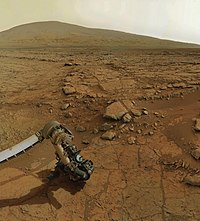
Back الحياة على الزهرة Arabic Vida a Venus Catalan Leben auf der Venus German Ζωή στην Αφροδίτη Greek Vida en Venus Spanish Bizia Artizarrean Basque زندگی در زهره Persian Vie sur Vénus French Élet a Vénuszon Hungarian Kehidupan di Venus ID

 |
| This article is one of a series on: |
| Life in the universe |
|---|
| Outline |
| Planetary habitability in the Solar System |
| Life outside the Solar System |
| Habitability of... |
The possibility of life on Venus is a subject of interest in astrobiology due to Venus' proximity and similarities to Earth. To date, no definitive evidence has been found of past or present life there. In the early 1960s, studies conducted via spacecraft demonstrated that the current Venusian environment is extreme compared to Earth's. Studies continue to question whether life could have existed on the planet's surface before a runaway greenhouse effect took hold, and whether a relict biosphere could persist high in the modern Venusian atmosphere.
With extreme surface temperatures reaching nearly 735 K (462 °C; 863 °F) and an atmospheric pressure 92 times that of Earth, the conditions on Venus make water-based life as we know it unlikely on the surface of the planet. However, a few scientists have speculated that thermoacidophilic extremophile microorganisms might exist in the temperate, acidic upper layers of the Venusian atmosphere.[1][2][3] In September 2020, research was published that reported the presence of phosphine in the planet's atmosphere, a potential biosignature.[4][5][6] However, doubts have been cast on these observations.[7][8]
As of 8 February 2021, an updated status of studies considering the possible detection of lifeforms on Venus (via phosphine) and Mars (via methane) was reported, though whether these gases are present is still unclear.[9] On 2 June 2021, NASA announced two new related missions to Venus: DAVINCI and VERITAS.[10]
- ^ Clark, Stuart (26 September 2003). "Acidic clouds of Venus could harbour life". New Scientist. Retrieved 30 December 2015.
- ^ Redfern, Martin (25 May 2004). "Venus clouds 'might harbour life'". BBC News. Retrieved 30 December 2015.
- ^ Dartnell, Lewis R.; Nordheim, Tom Andre; Patel, Manish R.; Mason, Jonathon P.; et al. (September 2015). "Constraints on a potential aerial biosphere on Venus: I. Cosmic rays". Icarus. 257: 396–405. Bibcode:2015Icar..257..396D. doi:10.1016/j.icarus.2015.05.006.
- ^ Cite error: The named reference
NatGeoDrakewas invoked but never defined (see the help page). - ^ Cite error: The named reference
NA-20200914was invoked but never defined (see the help page). - ^ Cite error: The named reference
NYT-20200914was invoked but never defined (see the help page). - ^ Plait, Phil (26 October 2020). "Update: Life Above Hell? Serious Doubt Cast on Venus Phosphine Finding". Retrieved 26 October 2020.
- ^ "Purported phosphine on Venus more likely to be ordinary sulfur dioxide". ScienceDaily. Retrieved 3 February 2021.
- ^ Chang, Kenneth; Stirone, Shannon (8 February 2021). "Life on Venus? The Picture Gets Cloudier - Despite doubts from many scientists, a team of researchers who said they had detected an unusual gas in the planet's atmosphere were still confident of their findings". The New York Times. Retrieved 8 February 2021.
- ^ Chang, Kenneth (2 June 2021). "New NASA Missions Will Study Venus, a World Overlooked for Decades - One of the spacecraft will probe the hellish planet's clouds, which could potentially help settle the debate over whether they are habitable by floating microbes". The New York Times. Retrieved 2 June 2021.